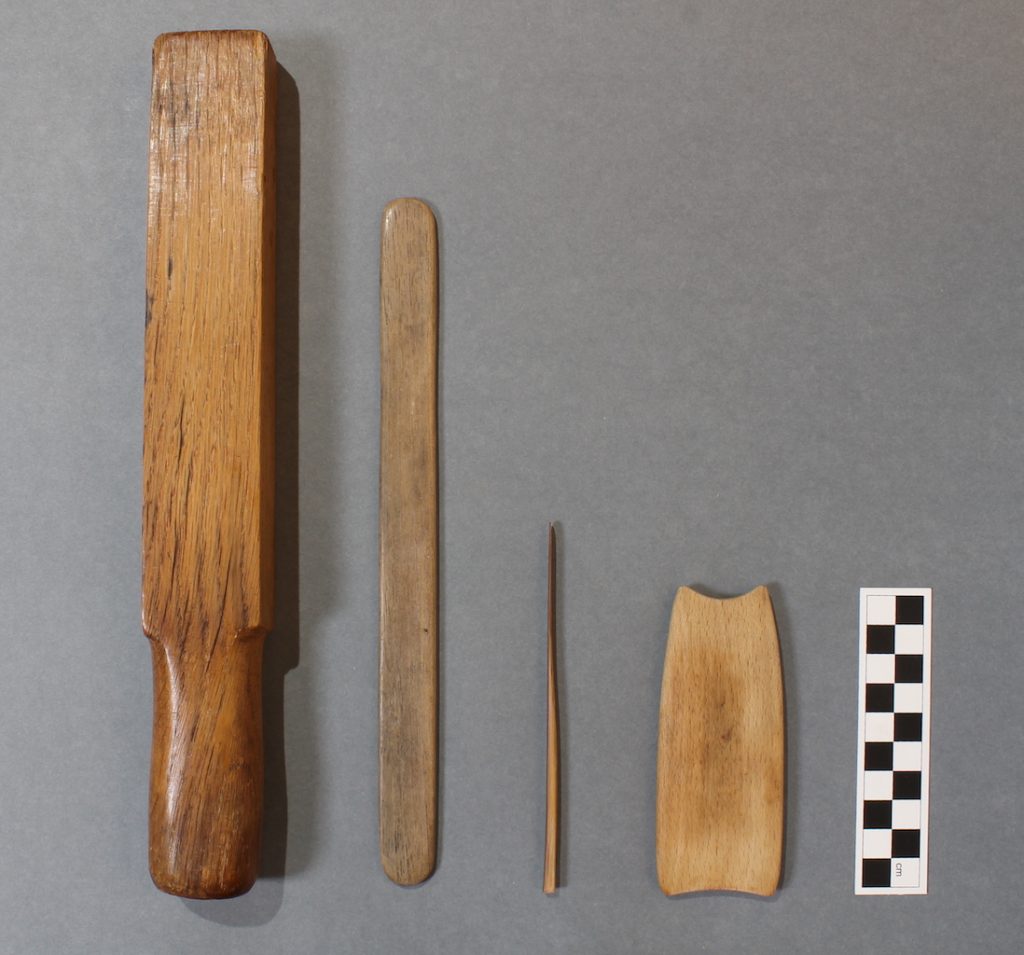
1. Knocking-down stick: This tool was given to me at one (I forget which) of the binderies I worked at in London in the noughties. It’s a worthless but very useful tool, which appears to have been roughly fashioned from an off-cut. It has some patina so has some age but would be hard to date. I use it regularly for gently tapping the sections into alignment when positioning a book in a laying press. I don’t, however, use it for its intended purpose of pressing down sections on a sewing frame, as I prefer consolidation sticks.[1]
2. Folding-stick: This item was also given to me at the beginning of my career when I was building my own collection of basic hand tools. I can’t say I was that excited about a wooden ‘bone-folder’ at the time but I added it to my tool box where it has laid undisturbed. Recently I have been doing some research and have had cause to go back through my collection of early bookbinding manuals. I was intrigued to notice that the term bone-folder is rarely used in the early nineteenth century accounts; instead we find the term folding-stick.[2] My folding-stick has some patina and signs of wear similar to that found on old bone-folders. Again, this tool is difficult to date, but could it be a nineteenth century folding-stick?
3. Bamboo Spatula: Made by me during my time at the Bodleian Library.[3] It’s a beautifully light and delicate tool which I use when I want something more gentle than a metal spatula. I was provided with some hardened, aged bamboo by colleague Robert Minte who also demonstrated how to remove the inner layers leaving the tough – but flexible – outer layer.
4. Frottoir: A tool more common in France and Germany than in England. Google tells me that the translation of this word from French to English is ‘scrub’; I would suggest, however, that the action is more of a firm rub. A frottoir has rounded ends and is used to close up the gaps between the backs of the sections and consolidate the shape of the spine. The action of rubbing down the spine-folds also helps to remove any excess adhesive. This example was whittled by me from an off-cut of beech in 2007. I use this tool periodically and do find it useful, but it is perhaps a little short. An interesting discussion on these tools can be found on Jeff Peachey’s website.[4] I tend to agree with Jeff’s argument that frottoirs (like those made by Talas) are too rounded. I find that the less rounded end of my frottoir was much more useful.
[1] For more on consolidation sticks see: Clarkson, Christopher. Some Thoughts on Sewing Frame Design for the Book Conservator, The Paper Conservator, Vol. 19, p. 47 (1995)
[2] The use of the term folding-stick can be found in: Parry, Henry. The Art of Bookbinding: Containing a Description of the Tools, Forwarding, Gilding… London: Baldwin, Craddock & Joy, 1818.
[3] Conservator, Megumi Mizumura gave a workshop on this subject for ICON in 2017 https://icon.org.uk/events/making-mini-spatulas-with-bamboo-and-teflon
[4] https://jeffpeachey.com/tag/frottoir/
Arthur Green, June 2020

You call a wooden handmade tool that I know you’d be very upset if you lost ” worthless “….?? How sad to use such a word, I call my own pieces of wood and bone creasers priceless…not worthless.
I quite agree! Worthless in monetary terms but priceless to me!